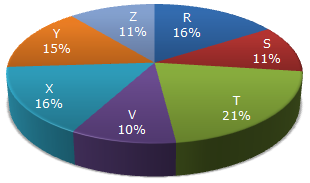| 1. |
If in 1999, the population of village R increase by 10% while that of village Z reduces by 5% compared to that in 1997 and the percentage of population below poverty line remains unchanged for all the villages, then find the approximate ratio of population of village R below poverty line to the ratio of population of village Z below poverty line for the year 1999. |
|||||||
Answer: Option A Explanation: Let the total population of all the seven village in 1997 be N.Then, population of village R in 1997 = 16% of N = 16N/100 and population of village Z in 1997 = 11% of N = 11N/100  Population of village R in 1999 Population of village R in 1999 = { 16N/100 + (10% of 16N/100) } = 1760N/10000 and population of village Z in 1999 = { 11N/100 - (5% of 11N/100)} = 1045N/10000 Now, population of village R below poverty line for 1999 = 51% of  1760N/10000 1760N/10000  and population of village Z below poverty line for 1999 = 42% of  1045N/10000 1045N/10000   = 51% of = 51% of  1760N/10000 1760N/10000  / 42% of / 42% of  1045N/10000 1045N/10000  = 51 x 1760 42 x 1045 = 2/1 |
Study the
following pie-chart and the table and answer the questions based on them.
Proportion of Population of Seven Villages in 1997

|
Village |
% Population Below Poverty Line |
|
X |
38 |
|
Y |
52 |
|
Z |
42 |
|
R |
51 |
|
S |
49 |
|
T |
46 |
|
V |
58 |
Post your comments here:
Name *:
Email : (optional)
Your comments will be displayed only after manual approval.